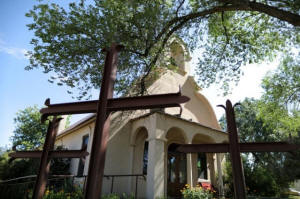|
Under Trump, more churches offer
sanctuary but few seek refuge
 Send a link to a friend
Send a link to a friend
 [August 01, 2017]
By Gabriella Borter [August 01, 2017]
By Gabriella Borter
NEW YORK (Reuters) - The number of American
churches declaring themselves sanctuaries for illegal immigrants has
more than doubled since President Donald Trump was elected, but only a
dozen people are known to be taking refuge there to avoid deportation.
Since Trump's victory in November, about 400 churches have declared
themselves sanctuaries, bringing the total to more than 800, according
to Church World Service, an international humanitarian nonprofit. The
surge came after Trump pledged to deport millions of undocumented people
from the United States.
But for immigrants seeking to avoid federal authorities, sanctuary
remains a last resort — and a potentially risky one.
“You need a certain mindset. You have to be a very strong-willed
individual who’s willing to make that personal sacrifice to make a
larger statement towards immigration law,” said Ray Ybarra Maldonado, a
Phoenix-based immigration attorney.
“It’s not just about an individual staying here; it’s something much
bigger than that,” said Ybarra Maldonado, who represented Mexican-born
Guadalupe Garcia de Rayos, who made headlines in February and was one of
the first illegal immigrants deported under Trump.

Nury Chavarria was the most recent immigrant to publicly take sanctuary
in a church. Her decision seems to have helped her win some relief in
the short term.
The Guatemalan-born mother of four was granted a stay of deportation on
Wednesday after spending six nights in Iglesia de Dios Pentecostal in
New Haven, Connecticut.
Chavarria, who has no criminal record, was previously granted a stay of
removal "on humanitarian grounds," according to Khaalid Walls, spokesman
for U.S. Immigration and Customs Enforcement (ICE). She came to the
attention of ICE after her application for asylum was denied in 1993,
her attorney said.
In June, during a routine ICE check-in, federal authorities told her she
had a month to return to Guatemala.
When illegal immigrants like Chavarria take sanctuary, they have no
guarantees. However, ICE policy discourages arrests at "sensitive
locations," which include places of worship.
The concept of “sanctuary” has roots in an ancient Judeo-Christian
tradition. Today, religious communities offering refuge do so as a
protest against federal immigration policy.
Still, as churches nationwide declare themselves sanctuaries, immigrants
are reluctant to accept their offer.
Garcia de Rayos decided against taking sanctuary in a church, her
attorney said.
“It’s almost like being incarcerated. You can’t live the life you want
to live,” said Ybarra Maldonado, Garcia’s lawyer.

[to top of second column] |

The United Methodist Church where undocumented immigrant Rosa Sabido
lives in sanctuary while facing deportation is seen in Mancos,
Colorado, U.S., July 19, 2017. REUTERS/Lucy Nicholson/File Photo

By complying with immigration authorities, Garcia knew that
deportation was likely. She was arrested when she showed up at her
February ICE check-in.
“In her mind, it was just as much a political statement as going
into sanctuary,” said Ybarra Maldonado.
For Chavarria, the decision to take sanctuary was not initially an
act of protest but a last-ditch effort to remain with her children,
according to Kica Matos, director of immigrant rights at the Center
for Community Change, which represents Chavarria. Still, she
attracted attention from Connecticut's two Democratic senators,
Chris Murphy and Richard Blumenthal, and Governor Dannel Malloy, who
rallied around her in support.
Like Chavarria, Jeanette Vizguerra appears to have benefited from
publicity surrounding her case.
Vizguerra took sanctuary at churches in Denver for 86 nights before
her application for a stay of deportation was approved in May.
U.S. Senator Michael Bennet and a pair of Democratic congressmen
introduced legislation that enabled her and another immigrant to
stay in the country until 2019 but did not provide relief to other
immigrants.
While Vizguerra was in sanctuary, Time magazine named her one of
2017's most influential people.
“The more high profile you can make your case, the more you can show
the government that the rest of the world is watching,” said Ybarra
Maldonado.

But Vizguerra and Chavarria are exceptions. There are still 12
immigrants known to be living in churches, hoping for legal relief.
Their uncertainty may be discouraging others from taking sanctuary.
"There's a lot of fear in the community," said Noel Andersen,
grassroots coordinator for immigrants' rights at Church World
Service. "The fear is that they could be stuck in a church for years
on end, or if their story is public, they may be more of a target."
(Editing by Frank McGurty and Lisa Shumaker)
[© 2017 Thomson Reuters. All rights
reserved.]
Copyright 2017 Reuters. All rights reserved. This material may not be published,
broadcast, rewritten or redistributed. |